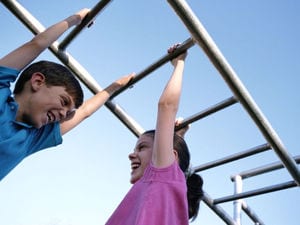
TUESDAY, April 24, 2018 (HealthDay News) — Confirming what many exhausted parents likely already know, scientists say a typical young boy is a sort of super athlete.
Compared with adults, preadolescent boys have a near matchless ability to endure and bounce back from high-intensity play, researchers report.
When it comes to post-exercise recovery, for example, an average boy between the ages of 8 and 12 can best elite adult triathletes, long-distance runners and cyclists, according to the new study.
Unfortunately, the findings also suggest that much of this youthful advantage fades with age.
“Our research indicates that aerobic fitness, at least at the muscle level, decreases significantly as children move into adulthood, which is around the time increases in diseases such as diabetes occur,” said study author Sebastien Ratel.
Ratel believes the new findings may provide clues to the development of those diseases.
“With the rise in diseases related to physical inactivity, it is helpful to understand the physiological changes with growth that might contribute to the risk of disease,” said Ratel, an associate professor in exercise physiology at the University Clermont Auvergne in France.
He and study co-author Anthony Blazevich also noted the findings may suggest ways to maximize a young child’s athletic potential.
“Our study shows that muscle endurance is often very good in children, so it might be better to focus on other areas of fitness such as their sports technique, sprint speed or muscle strength,” they said.
“This may help to optimize physical training in children, so that they perform better and enjoy sports more,” the researchers said in a statement.
Blazevich is a professor of biomechanics at Edith Cowan University in Perth, Australia.
To compare athletic performance across ages, the study team focused on 12 “untrained” prepubescent boys, 12 “untrained” men roughly between 19 and 23 years old, and 13 male athletes between 19 and 27 years old.
“Untrained” meant a healthy individual who engaged in recreational physical activity (such as snowboarding, skiing, skateboarding or climbing) for no more than four hours a week.
By comparison, the athletes were national level and had engaged in long-distance training a minimum of six times weekly for at least two years.
All performed strenuous cycling tests — separated by at least two days — designed to gauge “aerobic” and “anaerobic” performance.
Participants were asked to rate the difficulty of the cycling, from one to 10.
Also, blood samples were taken to test for blood lactate levels, an indicator of how much oxygen cells are getting. Higher levels mean your muscles are demanding more oxygen than the lungs can supply. When that happens, exertion is fueled by carbohydrate supply in the body (anaerobic activity).
This likely gives rise to greater muscle fatigue than oxygen-driven (aerobic) activity, the researchers suggested.
The researchers assessed each group’s ways of producing energy. Compared with untrained adults, children derived more of their energy aerobically than from the anaerobic process, the researchers found.
Children were also less tired and their muscles recovered much faster following their high-intensity workout.
By contrast, aerobic versus anaerobic energy patterns were the same among the boys and adult athletes. Muscle recovery and fatigue rates were also comparable, the researchers found.
But the boys actually outperformed the athletes in terms of heart rate recovery. The researchers suggested this is perhaps because of a superior ability to quickly return to pre-exercise blood lactate levels.
“This may explain why children seem to have the ability to play and play and play, long after adults have become tired,” said Ratel.
The findings were published April 24 in the journal Frontiers in Physiology.
More information
There’s more on the health benefits of physical activity at the U.S. National Heart, Lung, and Blood Institute.
